Resource Guarding is one of the most natural behaviours, for us humans and for our dogs.
🐶 It’s just that when our dogs do it, let’s say ‘excessively’ from our point of view, it doesn’t fit into our lifestyle.
💜 The key to addressing resource guarding is understanding, not confrontation.
➡️➡️ Instead of punishing your dog for growling or snapping - simply behaviours that communicate their discomfort - focus on:
✅ building trust (counter conditioning)
✅ management (avoiding situations where your dog feels the need to)
✅ positively teaching new skills that will allow you and your dog to easily navigate these situations (drop, leave, hand target, back, off, etc).
🛑 also rule out underlying heath niggles (you’d be surprised by how much GI issues or pain/ discomfort can play into resource guarding behaviours).
🐾 and ensure your dog’s basic needs are met, from providing them with a safe place to rest to being able to eat in peace.
Be an ACTIVIST for those who depend on you
Setting up your dog for training success
How to create a good dog training environment:
🐾 To begin with, train in a non-distracting environment to help your dog stay focused, then generalise the behaviours to more distracting environments.
🐾 Train when your dog is motivated.
🐾 Break behaviours down into small easy to learn steps.
🐾 Always allow your dog to opt out of the training when needed. For example, you may find your dog starts to sniff the floor suddenly, that’s her asking for a break.
🐾 Minimise opportunities for your dog to choose an incorrect response, providing you with repeated opportunities to positively reinforce all of your dog’s correct responses (mark & treat).
Things I tell my clients to make their puppies’ and adult dogs’ day to day the best they can be
Everything starts with and is influenced by learning to ‘talk dog’ and understanding your dog’s needs (both physically and emotionally).
Good quality socialisation and habituation, working at your dog’s pace, is so much more important than teaching traditional behaviours such as sit, down, etc.
On that note, a ‘sit’ isn’t as important as you think it is. And can matter of fact become an aversive for a dog with physical ailments. Don’t make it a default part of other behaviours you teach your dog.
Be your dog’s safe place and provide as much choice and agency as you can for your dog.
A happy tummy and gut makes for a happy dog!
Be more dog, you fur friend will love you for it.
Caring For Your Senior Dog
My little girl Wolfgang is about to turn 11 and, well, things are changing for her in terms of what she’s physically and mentally capable of. So, as she is the inspiration behind everything I do, I thought we’d share some tips on what to look out for as our dogs age and what you can do for them to ensure they continue to live their best life possible.
Why a trusting relationship with your dog is worth a million times more than any ‘obedience’ training
Yesterday, Wolfgang got a special, big treat (‘cause she’s the best!) in form of a sausage. And whenever she gets too big a piece and it needs dissecting, she usually finds herself a quiet spot to attend to it.
But we were all cosy on the sofa and I saw in her little face how she was ‘debating’ over whether to pop down or how to go about it.
So I offered my cupped hand and said ‘Do you want Mami to help?’. And she immediately dropped that juicy sausage on my hand and sat back, looking at me in anticipation while I broke it up into bite-sized pieces for her. Patiently waiting for me to feed her every delicious bit.
And these moments of trust are what it’s all about (for me, at least).
For a dog to let go of such a high value food without a worry in the world (and no, I’m not in her head but she looked blissfully zero bothered).
I use the ‘can I help’ cue for all sorts of situations including:
When she stepped into something and can’t get it out of here paws (I walk to her or she hobbles over to me).
When there is a little poo stuck and she can’t bum-shuffle it off (and gets quite freaked out over it).
When she tries to get to the end of the Kong but can’t quite get that last bit right at the top out.
If she tries to get to something but can’t quite reach….and much more
A few tips on how you can build a trusting relationship with your dog:
Learn to talk dog so you can understand and communicate with your dog, and within this….
Allow your dog choice and control over their environment
ALWAYS be your dogs safe place
Don’t mess with your dog’s resources, AKA what’s important to them.
That includes simply letting them eat their meals rather than making a whole song and dance around waiting for five minutes, then reciting the alphabet before they can dig in.
Accept your dogs personality: teach them cues so you can easily navigate this human world together but also accept that they might not want to allow strangers to pet them and that they, too, have crappy days where they might react to the environment.
Don’t use aversive methods!!!!
CHOICE MATTERS TO YOUR DOG!
Let’s face it, our dogs have very little choice and control over their day to day existence. They have no say over when they want to eat (or how much!!) or how much time to spend in the park. Whether they actually want that stranger to pat them on the head (while they can’t get away ‘cause there’s that thing called a lead that renders them stationary) or if this really is the ideal time to go to bed.
So whereas there are some things that we of course do no need to decide and manage on their behalf, in order to ensure they stay safe and healthy, providing choice for your dog wherever possible will make a huge difference to their overall wellbeing and will certainly improve the relationship you have with your furry friend.
Choice as well as being able to predict what happens next, whether that is via a routine or offering choice, make dogs feel safe. And feeling safe means less stress and more contentment; resulting in a confident, healthy and happy dog. What’s not to love?
Post Lockdown Syndrome is a Thing, Even for our Dogs!
As lockdown is easing across the UK, our puppies and adult dogs are faced with plenty of lifestyle changes that can be both stressful and plain scary. Understanding your dog’s fears as well as helping them to prepare for ‘the unknown’ is crucial to their wellbeing and to preventing unwelcome habits and behaviour issues from developing.
A problem area I’m working with a lot at the moment is people welcoming guests at their homes once again as well as heading out to busy public places such as busy pubs and restaurants, all with their dog in tow who simply can’t cope.
For all those pandemic puppies who’s never had a stranger visit their home these new experiences can be incredibly disruptive. As is for our adult dogs who’ve enjoyed a year of anti-social bliss and forgot what it’s like to be around more people than their closest family members.
Communication is the key to success
If you want your dog to learn and understand your language, then it’s only fair you can talk ‘dog’. Communication should always go two ways and understanding what your dog is telling you will result in a strong, trusting bond, which should be the basis of any training.
To talk ‘dog’ you have to look at your friend’s entire body (eyes, ears, mouth, tail, body stance, etc) as well as listen to the sounds he or she makes. Context and looking at the bigger picture is equally as important; for example a dog who yawns in the morning when he wakes up is tired, whereas a dog who yawns when a dog runs up to her in the park, is worried and potentially stressed.
Some subtle signs of communication to look out for when your dog feels stressed: eye blinking, lip/ nose licking, yawning, averting face/ gaze, lowered or tucked tail, frozen body posture, tightly closed mouth and much more.





